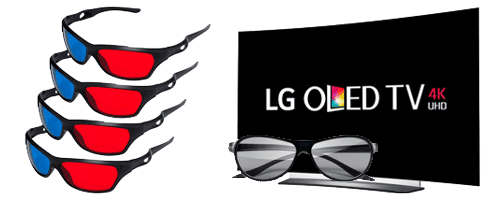
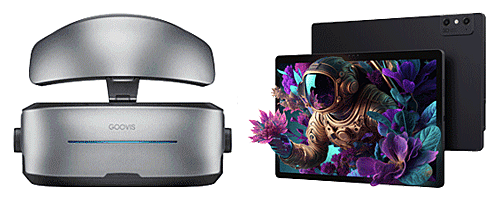
viewing real digital stereoscopic photographs
The key to viewing stereograms is being able to let each eye only see its corresponding or matching photograph.
The easiest way to enhance depth perception in the brain is to provide the eyes of the viewer with two different photographs, representing two perspectives of the same object, with a minor deviation equal or nearly equal to the perspectives that both eyes naturally receive in binocular vision
To avoid eyestrain and distortion, each of the two 2D photographs should be presented to the viewer so that any object at infinite distance is perceived by the eye as being straight ahead, the viewer's eyes being neither crossed nor diverging. When the picture contains no object at infinite distance, such as a horizon or a cloud, the pictures should be spaced correspondingly closer together.
(mirror stereoscope and widescreen computer monitor)
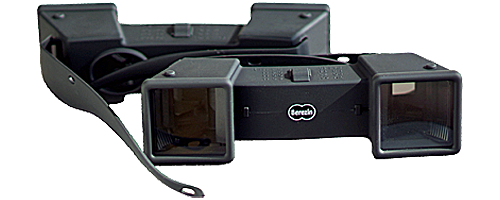
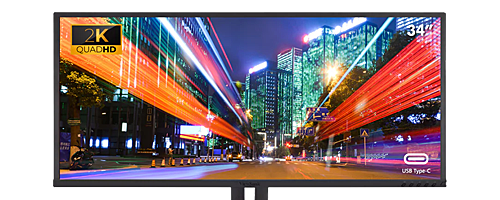
You can use a mirror stereoscope to view digital stereoscopic photographs on any device that has a colour screen such as a smartphone, computer monitor or television. The stereoscopic 3D effect is achieved by means of using mirrors to present each eye with the required image from a stereogram presented in side-by-side format. Good mirror stereoscope come with adjustable convergence to allow easy adjustment for different screen sizes and can be worn like glasses or held like conventional 3d viewers.
A mirror stereoscope can be used very successfully to create, edit and view stereograms using Stereo Photo Maker on a widescreen computer monitor.
(free-viewing)
Free-viewing is viewing a side-by-side photograph pair without using a viewing device. There are two methods by which you can free-view.
The cross-eyed viewing method swaps the left and right eye photographs so that they will be correctly seen cross-eyed, the left eye viewing the photograph on the right and vice versa. The fused three-dimensional photograph appears to be smaller and closer than the actual photographs, so that large objects and scenes appear miniaturized. This method is usually easier for free-viewing novices.
The parallel viewing method uses a photograph pair with the left-eye photograph on the left and the right-eye photograph on the right. The fused three-dimensional photograph appears larger and more distant than the two actual photographs, making it possible to convincingly simulate a life-size scene. The viewer attempts to look through the photograph with the eyes substantially parallel, as if looking at the actual scene.
(viewing on a smartphone with a simple vr adaptor)
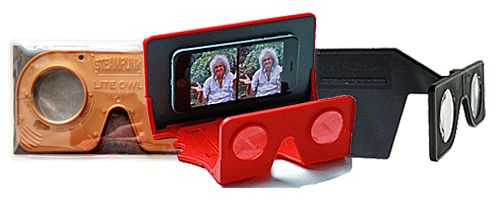
Most modern Smartphones have a means to allow you to upload photographs onto either the phones internal storage or a secondary SD card that has been added to the phone to increase it's storage capacity.
The aim of this next step it to upload/transfer your processed photographs onto your smartphone so that they can be opened and displayed on the phones screen and then viewed using a VR Adaptor attached to the phone.
Once transferred, the photographs can be viewed and enjoyed by anyone present. Some VR Adaptors have adjustment controls to see the effective screen distance and interpupillary distance to suit each viewer.
Side by side photographs viewed using a VR Adaptor and your Smartphone should not be more than 12cm wide (6cm per photograph)
Check that your Smartphone is running at its highest display resolution (the default resolution is normally lower to reduce power consumption) and that the adaptive brightness function (where available) is disabled when using it with a VR Adaptor.
(colour anaglyph glasses)
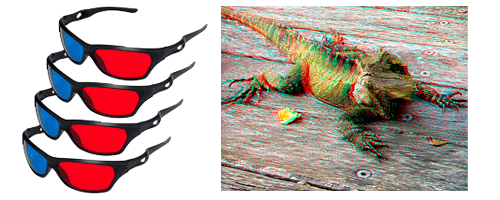
You can use colour anaglyph glasses to view digital stereoscopic photographs on any device that has a colour screen such as a smartphone, computer monitor or television. The stereoscopic 3D effect is achieved by means of encoding each eye's photograph using filters of different (usually chromatically opposite) colours, typically red and cyan. When viewed through the "color-coded" "anaglyph glasses", each of the two photographs reaches the eye it's intended for, revealing an integrated stereoscopic photograph. Anaglyph photographs are much easier to view than either parallel (diverging) or crossed-view pairs stereograms. However, these side-by-side types offer bright and accurate colour rendering, not easily achieved with anaglyphs.
(circularly polarized glasses)

You can use circularly polarized glasses to view digital stereoscopic photographs on any device that incorporates the required display technology. Passive 3D televisions and computer monitors blend two frames in one, alternating between horizontal lines of the frame meant for the left eye and the one for the right eye. Passive 3D glasses have different polarization on each lens that fits with their respective lines (right polarized for even lines, left for odd). The passive method of displaying stereoscopic photographs is better suited for large groups, since the expensive technology is primarily in the display rather than each pair of glasses. Passive glasses don't require a power source or batteries to view a 3D content. Passive 3D televisions and computer monitors have been out of production for several years now, but many are still sold after-market. LG manufactured a large range of passive 3D televisions between 2010 and 2016. The final Self-Lighting OLED 4K HDR 2016 models were the best.
(dlp projector and active shutter 3D glasses)

You can use active shutter 3D glasses combined with a Digital Light Processing (DLP) capable projector to view digital stereoscopic photographs on a fixed or portable screen. Projectors using the DLP technology, project alternating left and right eye images onto the screen. To create the 3D effect, the glasses must switch between blocking and allowing light to reach each eye, mirroring the projected images. To achieve synchronization, DLP Link uses a brief white flash of light between the left and right eye images. This flash is not intended to be visible to the viewer, but the glasses' sensors detect it and use it to determine when to switch the lenses. The "dark time" (the period between left and right eye images) is a crucial factor in DLP Link's performance, as it allows the glasses to switch lenses, minimizing crosstalk (when a small amount of the wrong eye's image leaks through). The dark time can vary between projector models. A modern true 4K 240Hz Laser DLP projector can be combined with a large white (preferably tensioned) screen (84" to 200" diagonal) to create an effective 3D Home Theatre Projection System.
(head-mounted displays)
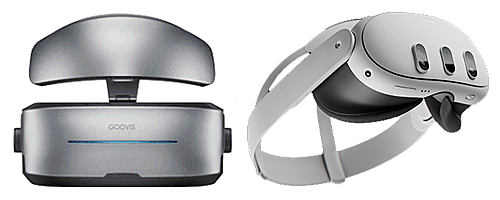
Head-mounted displays (HMD's) can present traditional stereograms in a personal virtual cinema. HMD's are constantly evolving and can now have 5K micro OLED screens with a FOV of 65 degrees or more. Suitable for personal viewing only the more advanced models include adjustment for intraocular distance and individual eye dioptre control. Meta Quest 3, Apple Vision Pro and Goovis G3 Max are all new entrants in this category
(autostereoscopic displays)
Autostereoscopic displays allow the perception of stereoscopic photographs with the naked eyes. A new range of devices with autostereoscopic displays have been released to market with many more coming. In terms of being able to share your stereoscopic photographs with others without the need for glasses is a welcome addition to the stereoscopic ecosystem and overcomes a primary barrier to the wider re-adoption of 3D.

The Leia Lume Pad 2 is a high-quality Android tablet which uses Diffractive Lightfield Backlighting (DLB) in its display. With 2D content, it projects out a bright 2560x1600 picture. But when the DLB is activated, lights pass through the DLB layer projects out eight views simultaneously, guided by face-tracking to create a dynamic 3D effect. Unlike other 3D solutions, Lume Pad 2 is brighter, thinner, and can instantly switch between full-quality 2D and 3D.
The included LeiaPlayer app is a Swiss army knife for playing back 3D media. This app does a whole lot more than simply play your 3D images and videos. It is a quick way to edit 3D depth and 3D focus for your 3D. If some files aren't detected as 3D, then you can manually add the "_2x1" to the filename or use the Manual 3D Tagging feature in LeiaPlayer, and if the 3D images don't look good, then you can consider converting SBS to LIF for auto-reconvergence or adding the reconvergence tags for those files.
| 3D Image File Format | Auto-reconvergence | Image Size and File naming syntax |
|---|---|---|
| Full-width Side-by-Side JPEG | On (forced) | 2560x1600* per image using "[image name]_reconv_2x1.jpg" |
| Full-width Side-by-Side JPEG | Off (default) | 2560x1600* per image using "[image name]_2x1.jpg" |
| Half-width Side-by-Side JPEG | On (forced) | 1280x1600 per image using "[image name]_reconv_2x1.jpg" |
| Half-width Side-by-Side JPEG | Off (default) | 1280x1600 per image using "[image name]_2x1.jpg" |
| Full-width Side-by-Side MPO | On (default) | 2560x1600* per image using "[image name].mpo" |
| Full-width Side-by-Side MPO | Off (forced) | 2560x1600* per image using "[image name]_noreconv.mpo" |
| Full-width Side-by-Side MPO | On (default) | 1280x1600 per image using "[image name].mpo" |
| Half-width Side-by-Side MPO | Off (forced) | 1280x1600 per image using "[image name]_noreconv.mpo" |
SBS has auto-reconvergence off by default. You can force auto-reconvergence on by adding "_reconv" to the filename of your media.
LIF, LVF, MPO, VR180, and 3D 360 content all have auto-reconvergence on by default.
You can disable auto-reconvergence by adding "_noreconv" to the filename of your media.
* The native resolution of a SBS image saved by the Lume Pad 2 dual 16MP rear cameras is 4656x2910 per image.
You may want to adopt this resolution if you plan to zoom into your images.
In a recent announcement for real digital stereoscopic photograph creators, Acer has announced a new 3D monitor under its 'SpatialLabs View' line for creators and developers. Called the SpatialLabs View Pro 27, it allows users to experience supported games and applications in stereoscopic 3D without glasses. On the hardware side, it features a 27-inch 4K (3840 x 2160) AHVA panel, offering 2K per eye in 3D mode. It has a 160Hz refresh rate, 178-degree viewing angle, 400 nits of brightness, 5ms response time, and a 1000:1 contrast ratio. How this monitor would work with existing applications such as StereoPhoto Maker is yet to be determined.
...
Jeff Ewen 3D - creating real digital stereoscopic photographs.
Contact me by clicking here.